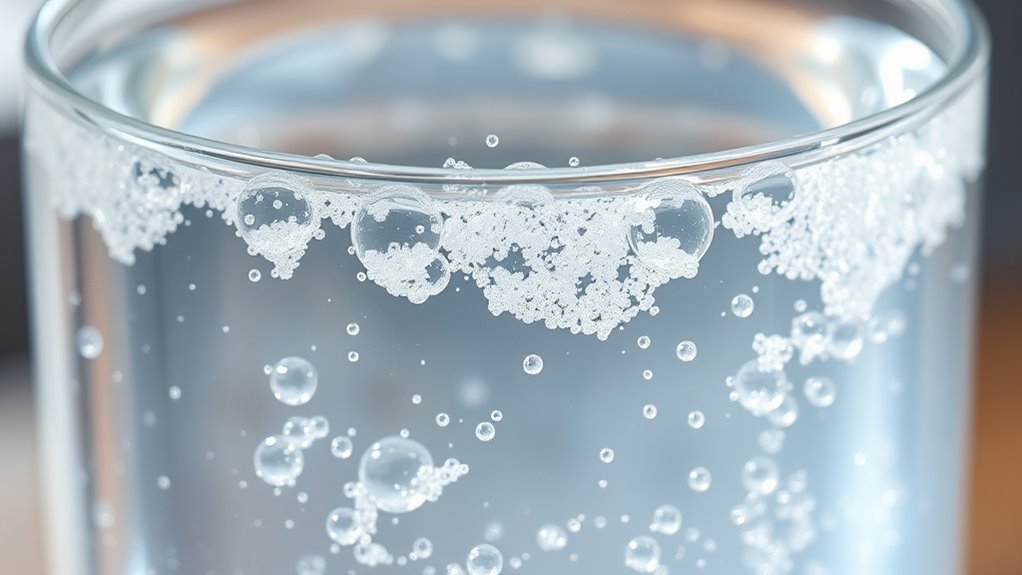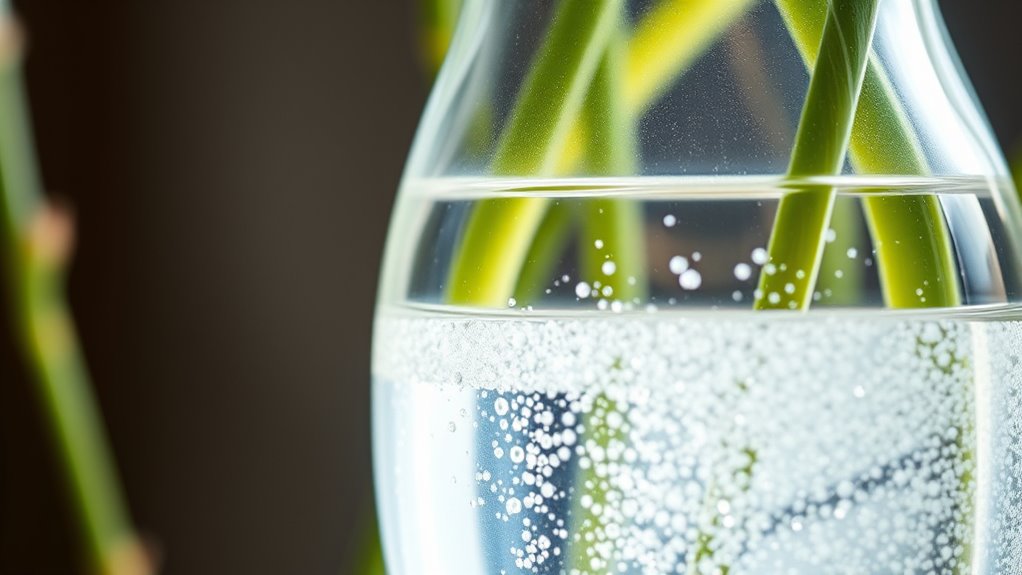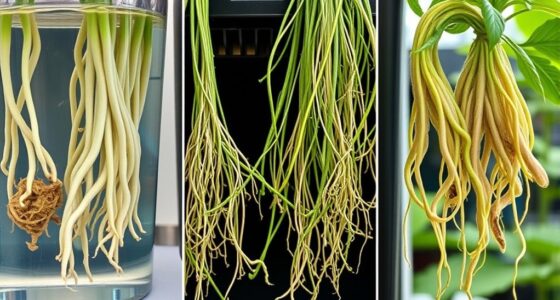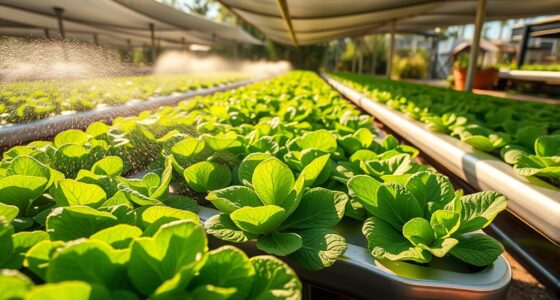Using silica in solution can be worth it if you want stronger, sturdier stems for your plants. Silica actively interacts with plant tissues, depositing in cell walls and reinforcing their structure. It also helps plants absorb and distribute nutrients better, boosting overall resilience against pests and diseases. Proper application guarantees silica remains bioavailable, maximizing benefits while avoiding issues like clogging. Keep exploring to discover how to optimize silica use for healthier, more vigorous plants.
Key Takeaways
- Silica in water forms a reactive, bioavailable solution that actively reinforces plant cell walls and stems.
- Proper silica application enhances plant strength, reducing breakage and supporting heavier fruit loads.
- Silica deposits within tissues improve resistance to pests, diseases, and environmental stresses.
- The solubility and effectiveness of silica depend on water pH, temperature, and formulation.
- Using specially formulated silica products ensures optimal bioavailability and maximizes stem strengthening benefits.

Have you ever wondered how silica behaves when it dissolves in water? When you add silica to your watering routine, it doesn’t simply mix and stay dissolved. Instead, silica, primarily in the form of silicic acid or soluble silica, disperses throughout the solution, creating a thin, protective film on plant surfaces and within the soil. This process is essential because silica isn’t just passive; it actively interacts with plant tissues, strengthening cell walls and boosting overall plant resilience. As you water your plants with silica-enriched solutions, you might notice that their stems become sturdier over time, thanks to the reinforcement of structural components at a cellular level.
When silica dissolves in water, it forms a reactive solution that can be absorbed by plants through their roots and, to some extent, through their foliage. The key here is the solubility: silica’s availability depends on the pH and temperature of the water, which influences how much silica remains in a form that plants can uptake. You’ll find that in well-balanced solutions, silica remains in a form that plants can readily absorb, leading to more robust growth. The silica particles or silicic acid molecules infiltrate the plant’s vascular system, depositing within cell walls and creating a more rigid, supportive framework. This process not only enhances stem strength but also improves the plant’s ability to resist pests and diseases.
However, it isn’t just about adding silica and expecting instant results. The chemistry behind silica in solution means that the concentration must be carefully managed. Too little, and you won’t see considerable benefits; too much, and you risk clogging your irrigation systems or causing nutrient imbalances. The solubility limits of silica in water mean that you need to use products formulated specifically for plant use, ensuring that the silica remains in a bioavailable form. When used correctly, silica solutions can be a game-changer for crops that require strong, resilient stems—such as tomatoes, peppers, and cucumbers—making harvests more abundant and plants less susceptible to breakage.
Understanding how silica behaves in solution and the factors that influence its solubility and uptake can help optimize application methods. In essence, dissolving silica in water creates a dynamic, bioactive solution that can substantially improve plant structure if used properly. Understanding how silica behaves in solution helps you optimize its application, ensuring your plants get the maximum benefit. When you appreciate the chemistry involved, you realize that silica isn’t just a supplement—it’s a powerful tool for building stronger, healthier stems and supporting overall plant vigor.
Frequently Asked Questions
How Quickly Does Silica Improve Stem Strength After Application?
You’ll typically notice stem strength improvement within a few weeks of applying silica, especially if you apply it consistently. The plant starts absorbing silica quickly, but visible results depend on factors like plant health, growth stage, and application method. Regular treatments, combined with proper nutrition, help reinforce cell walls, making stems sturdier over time. Patience and consistent use are key to seeing noticeable, lasting improvements.
Can Silica Be Used Safely on All Plant Types?
Think of silica as a versatile shield, but not all plants can wear it equally well. You can generally use silica safely on most plant types, including vegetables, ornamentals, and some fruits. However, some plants with sensitive roots or specific nutrient needs might react negatively. Always start with a small dose and observe how your plants respond, ensuring silica becomes a helpful ally rather than a harmful burden.
What Are the Signs of Silica Deficiency in Plants?
You might notice your plants have weak stems, become more prone to pests, or show leaf curling and yellowing if they lack silica. Stunted growth and reduced structural integrity are also signs. If your plants don’t seem as vigorous or resilient as usual, they could be silica deficient. Regularly inspect for these symptoms, and consider supplementing silica to help strengthen their stems and overall health.
Is Silica Beneficial During All Growth Stages?
Yes, silica benefits your plants at all growth stages by strengthening cell walls and improving resilience against pests and diseases. Think of silica as a natural armor that supports healthy development from seedling to maturity. During early stages, it enhances root growth, while later, it boosts stem strength and flower production. Incorporating silica consistently helps your plants grow sturdier, healthier, and more productive throughout their entire lifecycle.
Are There Any Risks of Overusing Silica Solutions?
Yes, overusing silica solutions can pose risks. You might experience nutrient imbalances, as excess silica can interfere with the uptake of other essential minerals like potassium and magnesium. It can also lead to blockages in your watering system or cause leaf spotting and stress in your plants. To avoid these issues, always follow recommended dosages and monitor your plants for signs of overapplication.
Conclusion
In the end, adding silica to your solution is like planting a sturdy backbone in your plants’ foundation. It’s not a magic wand, but it can fortify stems and give your crops the resilience to dance boldly in the wind. Think of silica as the silent guardian, weaving strength into every fiber. If you’re after plants that stand tall and firm, investing in silica might just be the secret ingredient to turning your garden into a fortress of growth.











